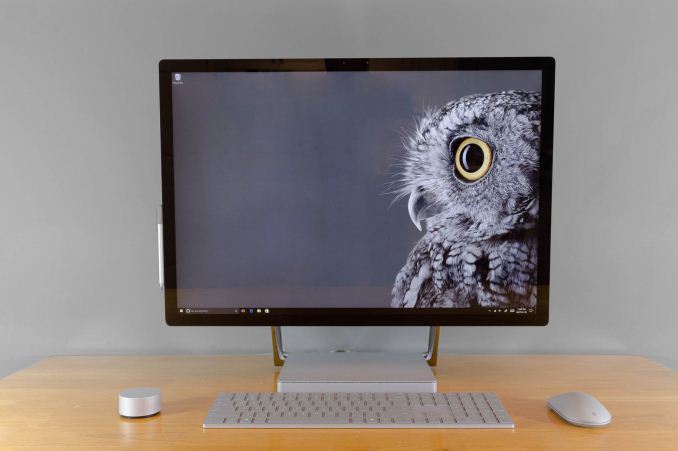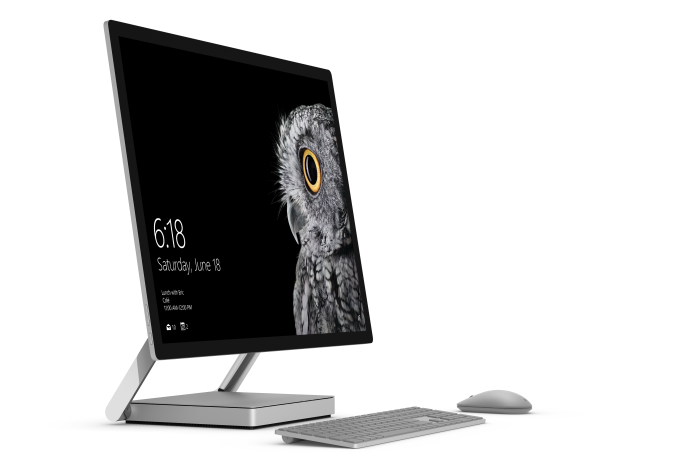The Microsoft Surface Studio Review
by Brett Howse on January 20, 2017 8:00 AM EST- Posted in
- Desktop
- Microsoft
- Surface
- Surface Studio

Microsoft has only been in the PC system game for a few years now, but over the last couple of years they have made a lot of progress rather quickly. These days they have a solid foundation of products available, with the Surface Pro 4 being one of the best convertible tablets, the Surface Book being a very solid convertible laptop, and also the more specialized products like the Hololens, and Surface Hub. Going into their October 2016 event, the one missing piece of their PC product lineup was a desktop computer, but with the announcement and release of the Surface Studio, that particular gap has now been filled.
But the Surface Studio is not your typical desktop PC. Even at first glance, the sleek, beautiful lines are readily apparent, and once powered on, it is rare for anyone to first glimpse the 28.125-inch 4500x3000 display and not say “wow”. It’s not only the very high resolution, but also the 3:2 aspect ratio that is unheard of in this segment, that makes the display stand out as something unique.
Microsoft has become one of the superlative hardware manufacturers in only the short span of four years or so, and the Surface Studio is one of their finest designs yet. However, from the very first Surface RT, Microsoft always tries to add something different, but more importantly interesting, to their designs, and in the case of the Surface Studio, it is the zero-gravity hinge, which allows the all-in-one to be quickly and easily tilted back to a 20° angle, letting it be used as a huge, digital drafting table. Microsoft announced the Surface Studio at their October Windows event, where they also announced the next Windows 10 Update, called the Creator’s Update, and it is wonderful to see them building hardware to truly bring out the exclusive features of their software.
Packed into the base of the Surface Studio is a laptop-class computer, with three different models available now. The base model, coming in at $2999, features an Intel Core i5-6440HQ processor, 8 GB of memory, a 1 TB hybrid drive with a 64 GB SSD cache, and a NVIDIA GeForce GTX 965M GPU. The mid-level model, which costs $3499, bumps the CPU up to an Intel Core i7-6820HQ, doubles the RAM to 16 GB, and doubles the SSD cache to a PCIe 128 GB model, with the same 1 TB HDD and GTX 965M. The highest priced model, at $4199, is an Intel Core i7-6820HQ, 32 GB of RAM, a 2 TB hybrid drive with a 128 GB PCIe cache, and a NVIDIA GTX 980M GPU with 4 GB of memory.
| Microsoft Surface Studio | ||||||
| Base | Middle | Top (As Tested) | ||||
| CPU | Intel Core i5-6440HQ Quad-Core, 2.6-3.5 GHz 6 MB Cache, 45W TDP, No Hyperthreading |
Intel Core i7-6820HQ Quad-Core, 2.7-3.6 GHz 8 MB Cache, 45W TDP, Hyperthreading |
||||
| GPU | NVIDIA GTX 965M 1024 CUDA Cores 944 Mhz + Boost 2 GB GDDR5 128-bit memory |
NVIDIA GTX 980M 1536 CUDA Cores 1038 Mhz + Boost 4 GB GDDR5 256-bit memory |
||||
| RAM | 8 GB DDR4 | 16 GB DDR4 | 32 GB DDR4 | |||
| Storage | 1 TB Hybrid Drive 64 GB SATA SSD Cache / 1 TB SATA HDD |
1 TB Hybrid Drive 128 GB PCIe SSD Cache / 1 TB SATA HDD |
2 TB Hybrid Drive 128 GB PCIe SSD Cache / 2 TB SATA HDD |
|||
| IO | 4 USB 3.0 ports - one high power port Full size SD Card Slot Headset Jack Xbox Wireless Connectivity DisplayPort |
|||||
| Display | 28.125-inch PixelSense Display 4500 x 3000 resolution 192 DPI sRGB, DCI-P3, P3 D65 color modes |
|||||
| Webcam | 5 MP Webcam Windows Hello Facial Recognition |
|||||
| Networking | Marvel AVASTAR 802.11ac Intel I219-LM Gigabit Ethernet |
|||||
| Price | $2,999 | $3,499 | $4,199 | |||
There was quite a bit of discussion at the time of the Surface Studio launch over the fact that it was equipped with older technology. Intel’s Kaby Lake quad-core parts just launched at CES this year, so Skylake quad-core CPUs were the latest generation available at launch. The Maxwell based graphics options chosen were not the latest generation mobile graphics from NVIDIA, with the GTX 965M and GTX 980M available in the Studio. The Pascal based GTX 1060 and GTX 1070 would have been much more powerful substitutes, but they are not pin-compatible drop-in components with the Maxwell GPUs in the Surface Studio, meaning a new board design and thermal considerations would have been necessary late in the design phase, and Microsoft appears to have been conservative here to avoid missing their launch window.
Microsoft has also been very conservative with their I/O choices, with four USB 3.0 Type-A ports on the back of the Studio, along with a SD card slot, and mini DisplayPort. As with the Surface Pro 4 and Surface Book, Microsoft has continued to provide only the older USB-A ports, and not even offer a single USB-C port, let alone with Thunderbolt. Anyone purchasing a Studio will likely be using it for several years, and the lack of USB-C is going to be an issue in the future, if not already today. The Surface team really needs to reconsider this as it is already a detriment to not include any.
There also must be some questions raised about the use of a hybrid drive in a PC of this price. We’ll dig in to the experience later, but Microsoft could and should offer a larger SSD as the boot disk, complimented by a HDD as a secondary disk, at least on the highest end model. A 512 GB NVMe SSD as the boot drive would appease much of the criticism. The computer does cost over $4000 after all, and while much of the cost of the device is in the display, SSDs have been the biggest improvement in user experience on the PC in a long time.











197 Comments
View All Comments
Sttm - Friday, January 20, 2017 - link
I can't rationalize a need for this product, and I really can't rationalize buying one, but I look at it and I love it. Hopefully by the 3rd generation they can get the price down to $1500, and I can buy one for the sake of having it.disappointed_reader - Friday, January 20, 2017 - link
As a long-time reader and fan of AnandTech, I am incredibly disappointed in this review. No display expert would ever recommend targeting a gamut other than sRGB under Windows. No color management is not a trivial detail - it's a fundamental problem, and color modes are a small band-aid, not an actual solution. As even the (imperfect) sRGB testing here shows, natively targeting P3 gamut inherently compromises sRGB accuracy, which should have been Microsoft's actual target.This display is no "masterpiece" - far from it. Maybe one day a miracle will happen and Win32 can somehow add color management, but FreeSync 2 and G-Sync HDR seem like the only possible hacks that will ever reasonably work.
id4andrei - Friday, January 20, 2017 - link
I think the author was praising the actual hardware when he said masterpiece. What you are rightfully complaining about is software.jlabelle2 - Sunday, January 22, 2017 - link
I read the contrary that in each color space targeted, the calibration out of the box is too notch.It is true that it is an issue that W10 is not color managed system wide like MacOS.
But this is very clever to have the ability to switch from a toggle in the Action Center.
In day to day activities, you are in sRGB.
And when you switch to Photoshop or video editing or Capture One Pro you switch to P3-65. That is honestly a very very clever implementation in regard of the current limitation.
sorten - Friday, January 20, 2017 - link
First of all, AnandTech, thank you for the "Illegal Photos" of large breasted Asian women who apparently live in North Korea. Who knew that so many NK women could afford and have access to breast implants?Secondly, I am a big fan of the Surface Studio. I'm not in the target market, but I still want one. If I were to consider it, then it would have to have 1) some usb-c connectors, at least one with TB3 support, 2) latest graphics from NVidia or AMD, 3) latest CPU from Intel or AMD. I'm sure those points will be addressed with the refresh and were a result of the release timing not quite working out.
serendip - Saturday, January 21, 2017 - link
Whaaa... Where??? I only saw owls!The price for the base model is rather optimistic given the mobile internals. How does the pricing compare to the iMac?
fanofanand - Monday, January 23, 2017 - link
Lucky! All I get is 9 boxes telling me why I should use revcontent for my advertising (I don't own a business). I'd WAY rather take N. Korean tatas! (no I don't mean the Indian car brand)BrokenCrayons - Monday, January 23, 2017 - link
Though it's been said before, advertising these days is usually targeted based on the recorded Internet usage habits of the individual. If you're seeing those sorts of ads, maybe it's time to reconsider what you're looking at on the Internet.Meteor2 - Friday, January 20, 2017 - link
The timing seems all wrong on this thing. With the 'Creator's Update' still months away, why didn't Microsoft plan the development of their hardware so they could include Type-C, TB3, NVMe, and a 10x0 GPU, and just release it a bit closer to the software which is supposed to make the most of this device?It's like the two departments aren't talking...
Shadowmaster625 - Friday, January 20, 2017 - link
The reason everyone says "wow" when they see the display is because they are thinking "Wow, you just spent $4000 on a $1200 screen and a $1200 computer."